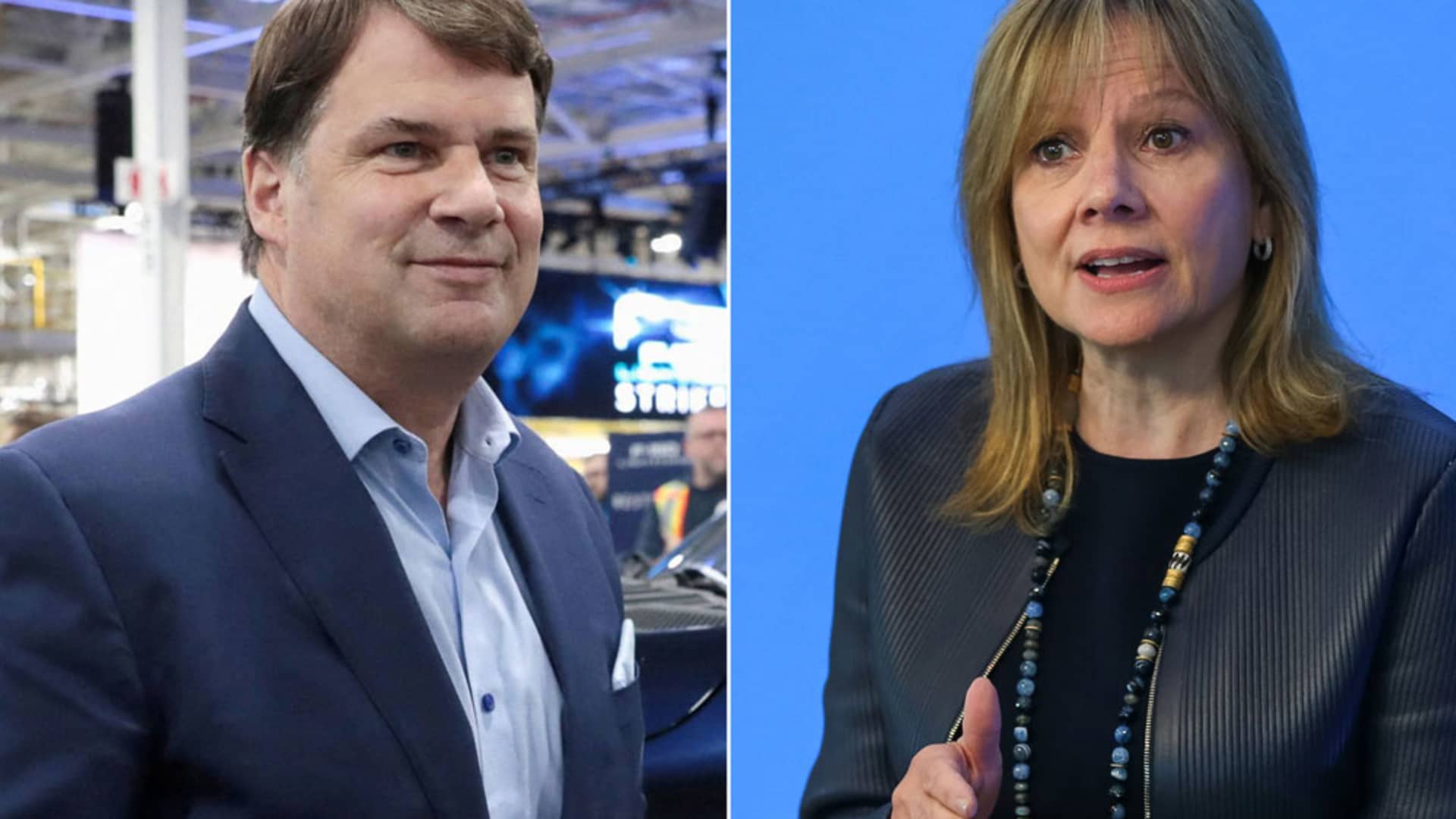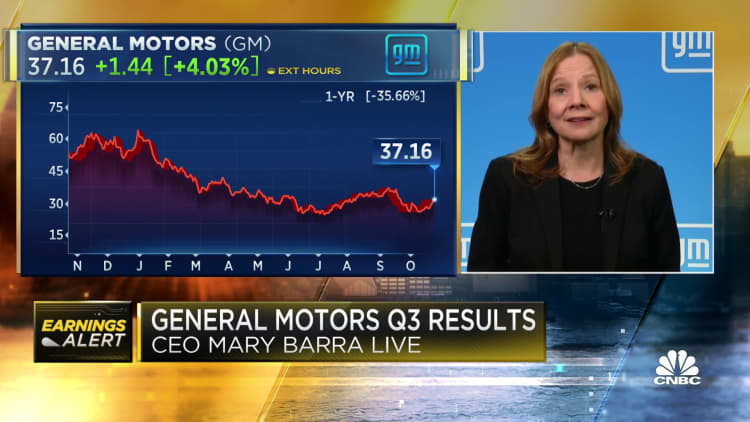
Jim Farley, CEO, Ford, left, and Mary Barra, CEO, General Motors
Reuters; General Motors
DETROIT — “Same industry. Two different companies.”
That’s how influential Morgan Stanley auto industry analyst Adam Jonas recently described General Motors and Ford Motor — bitter rivals for more than a century.
The two have consistently attempted to outgun each other in sales, performance and styling of new vehicles. GM has gained an edge in recent years on the back of better financials and early moves into electric and autonomous vehicles. GM most recently reported third-quarter results that, compared to Ford, knocked it out of the park.
The investment cases for America’s largest automakers are increasingly diverging as the companies — separated by just $1 billion in market value — have taken different tacks around electric and autonomous vehicles.
GM has been diversifying as much as possible around its emerging battery and self-driving vehicle businesses alongside a plan to exclusively offer electric vehicles by 2035. Ford is moving into EVs, too, but keeping up investments in its traditional businesses at the same time. Ford expects at least 40% of its sales globally to be electric vehicles by the end of this decade.
(Both companies continue to rely heavily on traditional sales of high-margin pickups and SUVs in the meantime, renewing their focus on the segment and leveraging billions of dollars in profit to pad investments in both autonomous and electric vehicles.)
Wall Street analysts say they’re watching the burgeoning segments for when, or if, one of the Detroit automakers can distinguish itself.
“It’s a very competitive industry, and they all tend to be pretty fast followers from that regard,” said Edward Jones analyst Jeff Windau. “It becomes difficult to really be differentiated over a long period of time.”
Ford is undergoing broad restructuring as part of CEO Jim Farley’s turnaround plan, called Ford+. Meanwhile, GM cut costs years ago under CEO Mary Barra.
“GM is definitely operating in a higher gear with the major difference in margins between the two companies right now,” Morningstar analyst David Whiston told CNBC. “GM went through a lot of that pain already a few years before.”

GM is quick to note its differences from Ford, and is likely to do so again on Thursday during an investor event. But the message never seems to take hold.
Wall Street maintains an average rating of “overweight” on both stocks, according to analyst reports compiled by FactSet. Both automakers are off more than 30% this year amid investor concerns that their profit heydays during the coronavirus pandemic are behind them in light of rising interest rates, inflation and recessionary fears.
Both stocks carry a market cap of around $54 billion — though GM trades for roughly $40 a share and Ford trades for closer to $14 a share — and trade seemingly alongside one another.
Autonomous investments
Late last month Ford announced it would disband its Argo AI autonomous vehicle unit saying it didn’t have faith in the business or its potential for monetization in the foreseeable future.
“It’s become very clear that profitable, fully autonomous vehicles at scale are still a long way off,” John Lawler, Ford’s chief financial officer, told reporters on Oct. 26. “We’ve also concluded that we don’t necessarily have to create that technology ourselves.”

A day earlier, GM Cruise CEO Kyle Vogt offered bullish comments about the growth of his company’s robotaxi business, including a “rapid scaling phase” with “meaningful revenue” starting next year.
“We’re seeing increased separation between the company’s operating commercial driverless services and those that are still stuck in the trough of disillusionment,” Vogt said, practically foreshadowing Ford’s announcement that it would dissolve Argo. “What’s happening here is that the companies with the best product have pulled ahead and are accelerating.”
Cruise recently said it was expanding its robotaxi service to cover most of San Francisco. It came months after the company commercially launched its self-driving vehicle fleet during limited hours at night.
“GM clearly is looking at this as a longer-term opportunity that they want to be part of,” said Sam Abuelsamid, principal analyst at Guidehouse Insights. “Ford is saying, ‘We think they’ll get there eventually, but it’s going to take a lot longer, and we have other fish to fry right now.'”
Ford’s other “fish” include billions spent on electric vehicles as well as lower-capability driver-assist technologies such as the automaker’s hands-free BlueCruise highway driving system.
‘Stuffing’ and selling
GM was among the first automakers to announce billions of dollars in new electric vehicle investments and set a target to end sales of internal combustion engine vehicles by 2035.
But Ford has been the one easily outselling GM in EVs, while GM prioritizes luxury models with its new battery technologies, including $100,000-plus Hummers and Bolt EVs with older battery technology.
“As with AVs, GM jumped in earlier,” Abuelsamid said. “But if you look, for example, beyond the auto industry, at the technology industry, being first to market in the long term there’s not necessarily a guarantee that you’re going to be successful.”
Ford sold 41,236 all-electric models through the first nine months of this year, while GM sold 22,830 — a majority of which were its older Bolt models.
Ford’s benefited from an EV strategy that’s allowed it to ramp up production faster than GM and get more vehicles on dealer lots. The company has taken popular vehicles with traditional gas engines and converted them into electric vehicles by “stuffing” battery packs into them.
GM, in contrast, has built a dedicated EV architecture. Ford plans to follow suit eventually, but it’s near-term approach has given it a head start in sales, and consumers don’t seem to mind. Ford also continues to produce hybrids and plug-in hybrid electric vehicles, which GM has decided not to do other than a potential “electrified” Corvette.
GM is the only automaker besides industry-leading Tesla producing its own battery cells through a joint venture in the U.S. The company has announced plans for four joint venture battery plants in the U.S., including one in Ohio that started commercial production of the cells earlier this year.
Ford has similar plans, allocating $5.8 billion to build twin lithium-ion battery plants in central Kentucky through a joint venture with South Korea-based SK, but production isn’t expected to start until 2026.
Edward Jones’ Windau said though GM may be ahead of Ford in the short term, others could catch up in the years ahead.
“Being able to move forward a little faster is an advantage,” he said. “It seems like a lot of the players are, again, following a similar approach.”







